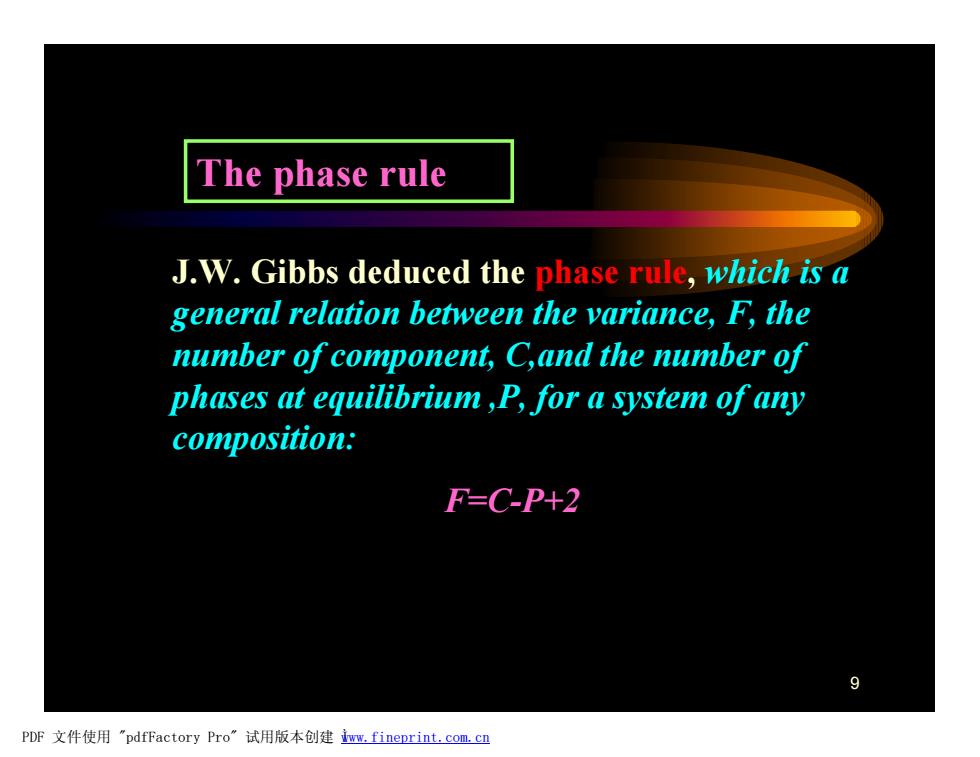
(c)For a liquid system,according to the solubility to decide whether a system consists of one phase or of two.For example,a solution of sodium chloride in water is a single phase.A pair of liquids that are partially miscible is a two-phase system(P=2) CaCO3(s)CaO(s)+CO,(g) Phase 1 Phase 2 Phase 3 6 PDF文件使用"pdfFactory Pro”试用版本创建fm,fineprint.com,cn
6 (c) For a liquid system, according to the solubility to decide whether a system consists of one phase or of two. For example, a solution of sodium chloride in water is a single phase. A pair of liquids that are partially miscible is a two-phase system(P=2) CaCO3 (s) F CaO(s) + CO2 (g) Phase 1 Phase 2 Phase 3 PDF 文件使用 "pdfFactory Pro" 试用版本创建 fwww.fineprint.com.cn

Species---means a chemical species(an ion or a molecular)that is present,denoted Component---The number of component is the minimum number ofindependent species necessary to define the composition of all the phase present in the system,denoted C. Usually C≤S (a)When the species do not react,C=S (b)If the species do react,and are at equilibrium, C=S-R R---the number of independent reactions PDF文件使用"pdfFactory Pro”试用版本创建ww,fineprint.com,cn
7 Species--- means a chemical species(an ion or a molecular) that is present, denoted S. Component---The number of component is the minimum number of independent species necessary to define the composition of all the phase present in the system, denoted C. Usually C≤S (a) When the species do not react, C=S (b) If the species do react, and are at equilibrium, C=S-R R---the number of independent reactions PDF 文件使用 "pdfFactory Pro" 试用版本创建 fwww.fineprint.com.cn

(c)The limited concentration in the same phase R'---the number of concentration limitation C=S-R-R' Note:S can be different according to your opinion,but C is only one for a given system. Degrees of freedom---is the number ofintensive variables that can be changed independently without disturbing the number of phases in equilibrium.denoted F. 8 PDF文件使用"pdfFactory Pro”试用版本创建m,fineprint.com,cn
8 (c) The limited concentration in the same phase R’---the number of concentration limitation C=S-R-R’ Degrees of freedom---is the number of intensive variables that can be changed independently without disturbing the number of phases in equilibrium. denoted F. Note: S can be different according to your opinion, but C is only one for a given system. PDF 文件使用 "pdfFactory Pro" 试用版本创建 Ìwww.fineprint.com.cn

The phase rule J.W.Gibbs deduced the phase rule,which is a general relation between the variance,F,the number of component,C,and the number of phases at equilibrium,P,for a system of any composition: F=C-P+2 9 PDF文件使用"pdfFactory Pro”试用版本创建wm,fineprint.com,cn
9 The phase rule J.W. Gibbs deduced the phase rule, which is a general relation between the variance, F, the number of component, C,and the number of phases at equilibrium ,P, for a system of any composition: F=C-P+2 PDF 文件使用 "pdfFactory Pro" 试用版本创建 Ìwww.fineprint.com.cn

Deduce the phase rule F=the total number of intensive variables the total number ofrelations Suppose:there are S species in every phase for P Phases Intensive variables:T,P,count as 2;there are S species in every phase for P Phases,so the total number of intensive variables is PS+2. Relations:because Exg=1 in every phase and there is P phases and He(1)=uB(2)=g(3)--B(P),the total number is S(P-1);there are R independent reactions and R'concentration limitations the total number of relations is P+S(P-1)+R+R So F=(PS+2)-/P+S(P-1)+R+RJ=S-R-R-P+2 F=C-P+2 10 PDF文件使用"pdfFactory Pro”试用版本创建wmw,fineprint.com,c四
10 Deduce the phase rule F=the total number of intensive variables-the total number of relations Suppose:there are S species in every phase for P Phases Intensive variables:T,P,count as 2; there are S species in every phase for P Phases,so the total number of intensive variables is PS+2. Relations:because ∑xB =1 in every phase and there is P phases ;and mB (1)=mB (2)=mB (3)=┄= mB (P),the total number is S(P-1);there are R independent reactions and R¢ concentration limitations the total number of relations is P+S(P-1)+R+R¢ So F=(PS+2)-[P+S(P-1)+R+R¢]=S-R-R¢-P+2 F=C-P+2 PDF 文件使用 "pdfFactory Pro" 试用版本创建 Ìwww.fineprint.com.cn